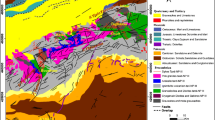Abstract
The Narmada-Son lineament (NSL) forms a major tectonic feature on the Indian subcontinent. The importance of this lineament lies in its evolution as well as its tectonic history. The lineament seems to have been active since Precambrian times. In order to understand the history of its evolution, it is necessary to know what igenous activity has been taking place along this lineament, and how the Deccan trap volcanics, which cover large areas along this lineament, have erupted.
For the study of this problem an analysis of the aeromagnetic anomaly map lying between 76°15′ to 77°30′E and 21°45′ to 22°50′N has been carried out. Four different profiles (B ′1 B 1,B ′2 B 2,B ′3 B 3 andB ′4 B 4) have been drawn in N-S direction over this area and interpreted in terms of the intrusive bodies present within or below the surface of Deccan trap exposures. Inversion and forward modelling techniques have been adopted for interpretation purposes. An analysis of frequency spectra along the profiles has also been carried out to estimate the average depth of the different magnetic bodies. These results have been correlated with the available geological information. It has been found that most of the small wavelength anomalies are caused by dyke-like bodies within or below the Deccan trap at a depth of less than 0.5 km.
Similar content being viewed by others
References
Alexander, P. O. (1979),Rare Earth Elements in Dharibuka Borehole Site, Deccan Basalt, W. India, J. Geol. Soc. India,20, 74–82.
Crawford, A. R. (1970),The Precambrian Geohydrology of Rajasthan and Bundelkhand, Northern India, Can. J. Earth. Sci.7, 91–110.
GSI (1964),The Geological Map of India, pub. by Geological Survey of India, Calcutta.
Gupta, Arindam (1982),Interpretation of Landsat Imagery of a Part of the Son Valley and its Correlation with Bouguer Gravity and Airborne Magnetic Anomaly Data, J. Geol. Soc. India23, 136–145.
Igbaluddin andMoghini, A. (1986),Stratigraphy of the Bijawar Group in Son Valley Mirzapur Dist. U.P. and Siddhi Dist. M.P., Geol. Sur. India. Spl. Publ.3, 81–93.
Kaila, K. L. (1988),Mapping the Thickness of Deccan Trap Flows from DSS Studies and Inferences about a Hidden Mesozoic Basin in Narmada-Tapti Region, Proc. Workshop on Deccan Flood Basalt, Geol. Soc. India, Mem.10, 91–116.
Krishnamachyrulu, S. K. G., Gopala Rao, Bh. V. V., andRadhakrishna Murthy, I. V. R. (1990),Magnetic Interpretation of Pair of Sheets and their Equivalence to Dyke, Pure and Appl. Geophys.32, (4), 719–731.
Krishnaswamy, V. S., andRavishanker (1980),Scope of Development, Exploration and Preliminary Assessment of the Geothermal Resource Potential of India, Rec. Geol. Surv. India111 (II), 17–40.
Murthy, T. V. G. R. K., andMishra, S. K. (1981),The Narmada-Son Lineament and the Structure of the Narmada-rift System, J. Geol. Soc. India22, 112–120.
Murthy, I. V. R., andMishra, D. C. (1989),Interpretation of Gravity and Magnetic Anomalies in Space and Frequency Domains, AEG Publication, Hyderabad, India, pp. 77–113.
NGRI (1975),Bouguer Gravity Anomaly Map, National Geophysical Research Institute, Hyderabad, India.
NGRI (1978),Aeromagnetic Anomaly Map of Narmada-Son Lineament, Block-II, National Geophysical Research Institute, Hyderabad, India.
Rao, B. S. R., andMurthy, I. V. R.,Gravity and magnetic method of Prospecting (Arnold-Heineman Publishers, India, Pvt. Ltd., New Delhi 1978) pp. 390–395.
Soni, M. K., Chakraborty, S., andJain, V. K. (1987),Vindhyan Super Group. A Review, Purana Basin of Peninsular India, Geol. Soc. India, Mem.6, 87–138.
Tugarinov, A. T., Sharin, L. L., Kazakov, G. A., andArakelyants, M. M. (1965),On the Glauconite Ages of Vindhyan System (India), Gaokhimiya6, 652–660.
Verma, R. K.,Geodynamics of the Indian Peninsula and the Indian Plate Margin (Oxford and IBH Publishers, New Delhi 1991) pp. 125–150.
Verma, R. K., andBanerjee, P. (1992),Nature of Continental Crust along the Narmada-Son Lineament Inferred from Gravity and Deep Seismic Sounding Data, Tectonophys.202, 375–397.
Vinogradov, A. P., Tugarinov, A. I., Zhykov, C., Stapnikova, N., Bibikova, E., andKhorre, K. (1964),Geochronology of Precambrians of India, 22nd Int. Geol. Cong.10, 553–567.
West, W. D. (1962),The Line of the Narmada-Son Valley, Curr. Sci.31, (4), 143–144.
Author information
Authors and Affiliations
Rights and permissions
About this article
Cite this article
Verma, R.K., Dutta, U. Analysis of aeromagnetic anomalies over the central part of the Narmada-Son lineament. PAGEOPH 142, 383–405 (1994). https://doi.org/10.1007/BF00879311
Received:
Revised:
Accepted:
Issue Date:
DOI: https://doi.org/10.1007/BF00879311




